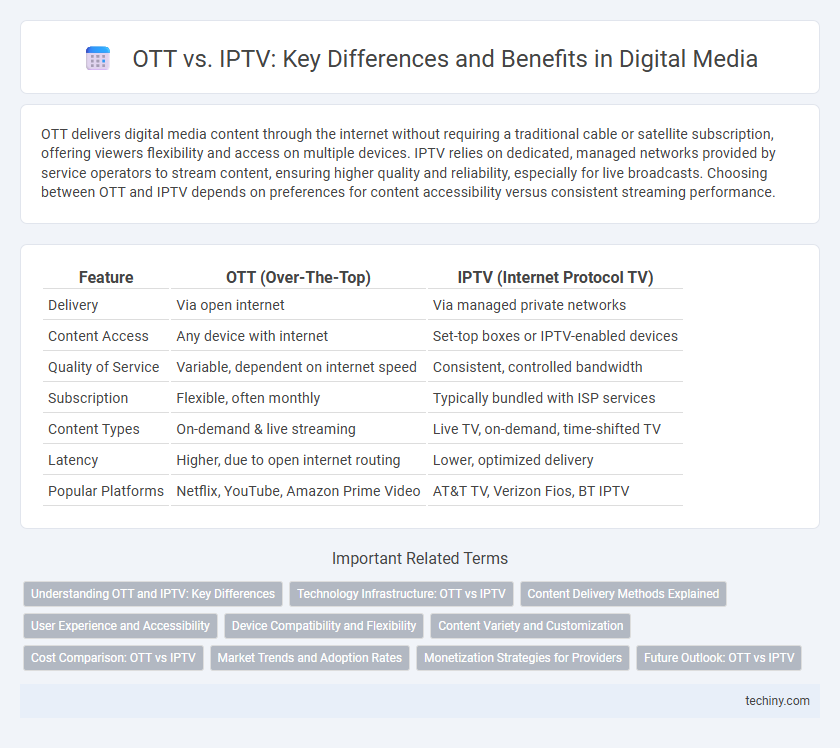OTT delivers digital media content through the internet without requiring a traditional cable or satellite subscription, offering viewers flexibility and access on multiple devices. IPTV relies on dedicated, managed networks provided by service operators to stream content, ensuring higher quality and reliability, especially for live broadcasts. Choosing between OTT and IPTV depends on preferences for content accessibility versus consistent streaming performance.
Table of Comparison
| Feature | OTT (Over-The-Top) | IPTV (Internet Protocol TV) |
|---|---|---|
| Delivery | Via open internet | Via managed private networks |
| Content Access | Any device with internet | Set-top boxes or IPTV-enabled devices |
| Quality of Service | Variable, dependent on internet speed | Consistent, controlled bandwidth |
| Subscription | Flexible, often monthly | Typically bundled with ISP services |
| Content Types | On-demand & live streaming | Live TV, on-demand, time-shifted TV |
| Latency | Higher, due to open internet routing | Lower, optimized delivery |
| Popular Platforms | Netflix, YouTube, Amazon Prime Video | AT&T TV, Verizon Fios, BT IPTV |
Understanding OTT and IPTV: Key Differences
OTT (Over-the-Top) delivers streaming content directly over the internet without traditional broadcast or cable infrastructure, enabling on-demand access via platforms like Netflix and Hulu. IPTV (Internet Protocol Television) transmits television content through private, managed networks, often provided by telecom operators, offering linear channels and interactive features. The key difference lies in OTT's reliance on open internet delivery versus IPTV's controlled, subscription-based network environment.
Technology Infrastructure: OTT vs IPTV
OTT leverages the public internet infrastructure, delivering video content via HTTP streaming protocols, which allows for on-demand access and scalability without relying on dedicated networks. IPTV uses private, managed IP networks to provide controlled and consistent quality of service (QoS) with multicast capabilities, often integrating with telecom operators' infrastructure for live TV and video-on-demand services. The key technological difference lies in OTT's dependency on open internet protocols versus IPTV's reliance on closed, operator-controlled IP networks ensuring lower latency and guaranteed bandwidth.
Content Delivery Methods Explained
OTT (Over-The-Top) delivers content via the open internet, allowing users to stream videos with flexible access on various devices without traditional broadcast infrastructure. IPTV (Internet Protocol Television) uses dedicated, private IP networks, ensuring higher bandwidth control and quality of service for delivering live TV channels and on-demand content. Both methods optimize digital media distribution, with OTT focusing on wide accessibility and IPTV emphasizing controlled, reliable delivery.
User Experience and Accessibility
OTT platforms provide seamless, on-demand streaming accessible across multiple devices without the need for dedicated hardware, enhancing user convenience and flexibility. IPTV delivers content via private networks with consistent quality and lower latency, offering a stable viewing experience ideal for live broadcasts and interactive services. Both OTT and IPTV emphasize user-friendly interfaces, but OTT excels in broader accessibility, while IPTV prioritizes reliability and integration within home networks.
Device Compatibility and Flexibility
OTT services offer broad device compatibility, supporting smartphones, tablets, smart TVs, and gaming consoles, enabling seamless streaming across various platforms without the need for specialized hardware. IPTV typically requires specific set-top boxes or compatible devices connected to a managed network, limiting flexibility compared to OTT's open internet-based delivery. The inherent adaptability of OTT platforms allows users to switch devices effortlessly, while IPTV's dependency on dedicated infrastructure restricts its use primarily to fixed locations.
Content Variety and Customization
OTT platforms offer extensive content variety across genres and regions, enabling users to access a diverse library of movies, TV shows, and original productions on demand. IPTV provides customized viewing experiences tailored to user preferences through interactive features, personalized channel lineups, and targeted content recommendations. The flexibility of OTT's global content combined with IPTV's personalization capabilities enhances user engagement and satisfaction in digital media consumption.
Cost Comparison: OTT vs IPTV
OTT services typically incur lower infrastructure and maintenance costs compared to IPTV, as they rely on public internet networks rather than dedicated fiber or satellite connections. IPTV requires significant upfront investment in proprietary network infrastructure, including set-top boxes and managed bandwidth, leading to higher operational expenses. OTT's flexible scalability and minimal hardware dependency make it a more cost-effective solution for content delivery in digital media.
Market Trends and Adoption Rates
OTT platforms dominate the digital media space with a 30% higher adoption rate than IPTV, driven by flexible content delivery and lower infrastructure costs. Market trends indicate OTT's rapid growth, projected to surpass $200 billion globally by 2026, fueled by increasing smartphone penetration and demand for on-demand streaming. IPTV retains a strong presence in regions with established broadband infrastructure, appealing to users seeking bundled services and stable, high-quality streams.
Monetization Strategies for Providers
OTT platforms leverage subscription-based models, advertising, and transactional video-on-demand to maximize revenue streams, targeting diverse consumer preferences with flexible pricing. IPTV providers often depend on bundled service packages and premium channel add-ons, combining subscription fees with targeted advertising to enhance profitability. Both models harness data analytics to optimize user engagement and personalize offers, driving higher average revenue per user (ARPU) and reducing churn rates.
Future Outlook: OTT vs IPTV
OTT platforms are expected to dominate the digital media landscape by offering flexible, on-demand content accessible across multiple devices with minimal infrastructure requirements. IPTV will maintain a niche presence, primarily driven by telecommunications providers focusing on high-quality, live broadcast and interactive services. Emerging technologies like 5G and AI-driven personalization will further accelerate OTT growth and enhance user experience, shaping the future of content consumption.
OTT vs IPTV Infographic

 techiny.com
techiny.com